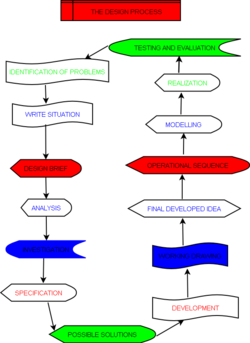Lesson 4: The Design Process
Contents
Introduction
The Design Process is a modern approach to the teaching of practical skills in schools, colleges and universities. It is sometimes called Product Design. The process has variousstages through which the design and construction of an object is taken through. The Design Process is illustrated diagrammatically in figure 1.
By the end of the lesson, learners will be able to:
|
Lesson Content
Definition of design
Designing is an activity which involves the use of a wide range of experiences, knowledge and skills to find the best soloution to a problem within certain constraints. Designing entails identifying and clarifying problems, making thoughtful responses and then creating and testing your sulution.
Framework of design
One may wonder why manufacturers have to go through the process of designing instead of manufacturing right away in the workshop. In a way, we are likely to ask the question 'should it be 'process' before 'product' or vice versa'? There are many different methods of solving a problem. A framework is a series of linked stages which will help solve a problem. It is needed to support the design work. The framework makes the design easier
Advantages of the Design Process
The process has many advantages compared with the traditional method of teaching practical skills. Some of these are:
- it brings out (unearths) the creative potential of the learner.
- It suppresses the spirit of copying in class.
- It is student-centred as learners play active role in planning the practical lesson and skills.
- It relates learners' learning outcomes to real life situations.
- It imbibes the spirit of researching in students.
- It encourages learners to to become aware of the problems around them.
Now let's look at some of the disadvantages of the Design Process.
Disadvantages
- It is time consuming

